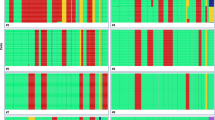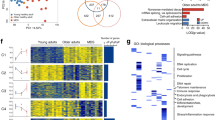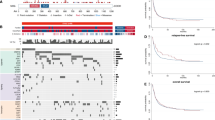Abstract
Aneuploidy is considered to play an important role in the pathogenesis of malignancies. We were interested whether abnormalities of the sister-chromatid separation regulator and proto-oncogene hSecurin occurred in myeloid leukaemias, and whether such abnormalities correlated with aneuploidy. The expression of hSecurin was assessed by real-time quantitative PCR in samples from patients with acute myeloid leukaemia (AML, n=70), chronic myeloid leukaemia (CML) in chronic phase (CP, n=20) or blast phase (BP, n=12), and granulocytes as well as mononuclear cells (MNCs) from healthy donors (n=21). Median hSecurin expression in AML with normal karyotypes was not significantly different from AML showing aneuploidy, CML BP or cells from healthy donors. However, hSecurin expression in CML CP was significantly increased compared to AML with normal karyotypes (1.82-fold; P<0.001), CML BP (3.18-fold; P<0.001), MNCs (3.17-fold; P<0.001) and granulocytes (2.69 fold; P<0.001) from healthy donors. Mutations in the coding region of hSecurin were not detected. These results do not support a major role of hSecurin in the development of aneuploidy in myeloid leukaemias. However, high expression of hSecurin may be of pathogenetic relevance in a subset of patients with regard to its potential to stimulate angiogenesis and to interact with the DNA-damage response pathway.
This is a preview of subscription content, access via your institution
Access options
Subscribe to this journal
Receive 12 print issues and online access
$259.00 per year
only $21.58 per issue
Buy this article
- Purchase on Springer Link
- Instant access to full article PDF
Prices may be subject to local taxes which are calculated during checkout

Similar content being viewed by others
References
Jallepalli PV, Lengauer C . Chromosome segregation and cancer: cutting through the mystery. Nat Rev Cancer 2001; 1: 109–117.
Grimwade D, Walker H, Oliver F, Wheatley K, Harrison C, Harrison G et al. The importance of diagnostic cytogenetics on outcome in AML: analysis of 1612 patients entered into the MRC AML 10 trial. Blood 1998; 92: 2322–2333.
Slovak ML, Kopecky KJ, Cassileth PA, Harrington DH, Theil KS, Mohamed A et al. Karyotypic analysis predicts outcome of preremission and postremission therapy in adult acute myeloid leukemia: a Southwest Oncology Group/Eastern Cooperative Oncology Group study. Blood 2000; 96: 4075–4083.
Byrd JC, Mrozek K, Dodge RK, Carroll AJ, Edwards CG, Arthur DC et al. Pretreatment cytogenetic abnormalities are predictive of induction success, cumulative incidence of relapse, and overall survival in adult patients with de novo acute myeloid leukemia: results from Cancer and Leukemia Group B (CALGB 8461). Blood 2002; 100: 4325–4336.
Nishii K, Usui E, Katayama N, Lorenzo F, Nakase K, Kobayashi T et al. Characteristics of t(8;21) acute myeloid leukemia (AML) with additional chromosomal abnormality: concomitant trisomy 4 may constitute a distinctive subtype of t(8;21) AML. Leukemia 2003; 17: 731–737.
Farag SS, Archer KJ, Mrozek K, Vardiman JW, Carroll AJ, Pettenati MJ et al. Isolated trisomy of chromosomes 8, 11, 13 and 21 is an adverse prognostic factor in adults with de novo acute myeloid leukemia: results from Cancer and Leukemia Group B 8461. Int J Oncol 2002; 21: 1041–1051.
Faderl S, Talpaz M, Estrov Z, O'Brien S, Kurzrock R, Kantarjian HM . The biology of chronic myeloid leukemia. N Engl J Med 1999; 341: 164–172.
Cahill DP, Kinzler KW, Vogelstein B, Lengauer C . Genetic instability and Darwinian selection in tumors. Trends Cell Biol 1999; 9: M57–M60.
Nasmyth K, Peters JM, Uhlmann F . Splitting the chromosome: cutting the ties that bind sister chromatids. Science 2000; 288: 1379–1384.
Yanagida M . Cell cycle mechanisms of sister chromatid separation; roles of Cut1/separin and Cut2/securin. Genes Cells 2000; 5: 1–8.
Hornig NCD, Knowles PP, McDonald NQ, Uhlmann F . The dual mechanism of separase regulation by securin. Curr Biol 2002; 12: 973–982.
Zou H, McGarry TJ, Bernal T, Kirschner MW . Identification of a vertebrate sister-chromatid separation inhibitor involved in transformation and tumorigenesis. Science 1999; 285: 418–422.
Pei L, Melmed S . Isolation and characterization of a pituitary tumor-transforming gene (PTTG). Mol Endocrinol 1997; 11: 433–441.
Zhang X, Horwitz GA, Prezant TR, Valentini A, Nakashima M, Bronstein MD et al. Structure, expression and function of human pituitary tumor-transforming gene (PTTG). Mol Endocrinol 1999; 13: 156–166.
Zur A, Brandeis M . Securin degradation is mediated by fzy and fzr, and is required for complete chromatid separation but not for cytokinesis. EMBO J 2001; 20: 792–801.
Yu R, Heaney AP, Lu W, Chen J, Melmed S . Pituitary tumor-transforming gene causes aneuploidy and p53-dependent and p53-independent apoptosis. J Biol Chem 2000; 275: 36502–36505.
Jallepalli PV, Waizenegger IC, Bunz F, Langer S, Speicher MR, Peters JM et al. Securin is required for chromosomal stability in human cells. Cell 2001; 105: 445–457.
Zhang X, Horwitz GA, Heaney AP, Nakashima M, Prezant TR, Bronstein MD et al. Pituitary tumor-transforming gene (PTTG) expression in pituitary adenomas. J Clin Endocrinol Metab 1999; 84: 761–767.
Heaney AP, Singson R, McCabe CJ, Nelson V, Nakashima M, Melmed S . Expression of pituitary tumor-transforming gene in colorectal tumours. Lancet 2000; 355: 716–719.
Saez C, Pereda T, Borrero JJ, Espina A, Romero F, Tortolero M et al. Expression of hpttg proto-oncogene in lymphoid neoplasias. Oncogene 2002; 21: 8173–8177.
Vardiman JW, Harris NL, Brunning RD . The World Health Organisation (WHO) classification of the myeloid neoplasms. Blood 2002; 100: 2292–2302.
Ginzinger DG . Gene quantification using real-time quantitative PCR: an emerging technology hits the mainstream. Exp Hematol 2002; 30: 503–512.
Lion T . Current recommendations for positive controls in RT-PCR assays. Leukemia 2001; 15: 1033–1037.
Mitelman F, (ed.), ISCN (1995). An International System for Human Cytogenetic Nomenclature. Basel, Switzerland: S Karger, 1995.
Gerdes J, Lemke H, Baisch H, Wacker HH, Schwab U, Stein H . Cell cycle analysis of a proliferation-associated human nuclear antigen defined by the monoclonal antibody Ki-67. J Immunol 1984; 133: 1710–1715.
Dominguez A, Ramos-Morales F, Romero F, Rios RM, Dreyfus F, Tortolero M et al. hpttg, a human homolog of rat pttg, is overexpressed in hematopoietic neoplasms. Evidence for a transcriptional activation function of hPTTG. Oncogene 1998; 17: 2187–2193.
Löwenberg B, Downing JR, Burnett A . Acute meyloid leukemia. N Engl J Med 1999; 341: 1051–1062.
O'Brien SG, Guilhot F, Larson RA, Gathmann I, Baccarani M, Cervantes F et al. Imatinib compared with interferon and low-dose cytarabine for newly diagnosed chronic-phase chronic myeloid leukemia. N Engl J Med 2003; 348: 994–1004.
Wattel E, Preudhomme C, Hecquet B, Vanrumbeke M, Quesnel B, Dervite I et al. p53 mutations are associated with resistance to chemotherapy and short survival in hematological malignancies. Blood 1994; 84: 3148–3157.
Christiansen DH, Andersen MK, Pedersen-Bjergard J . Mutations with loss of heterozygosity of p53 are common in therapy-related myelodysplasia and acute myeloid leukemia after exposure to alkylating agents and significantly associated with deletion or loss of 5q, a complex karyotype, and a poor prognosis. J Clin Oncol 2001; 19: 1405–1413.
Bernal JA, Luna R, Espina A, Lazaro I, Ramos-Morales F, Romero F et al. Human securin interacts with p53 and modulates p53-mediated transcriptional activity and apoptosis. Nat Genet 2002; 32: 306–311.
Zhou Y, Mehta KR, Choi AP, Scolavino S, Zhang X . DNA-damage induced inhibition of securin expression is mediated by p53. J Biol Chem 2003; 278: 462–470.
Rustgi AK . Securin a new role for itself. Nat Genet 2002; 32: 222–224.
Cahill DP, Lengauer C, Yu J, Riggins GJ, Willson JKV, Markowitz SD et al. Mutations of mitotic checkpoint genes in human cancers. Nature 1998; 392: 300–303.
Hernando E, Orlow I, Liberal V, Nohales G, Benezra R, Cordon-Cardo C . Molecular analyses of the mitotic checkpoint components hsMAD2, hBUB1, and hBUB3 in human cancer. Int J Cancer 2001; 95: 223–227.
Ru HY, Chen RL, Lu WC, Chen JH . HBUB1 defects in leukemia and lymphoma cells. Oncogene 2002; 21: 4673–4679.
Tighe A, Johnson VL, Albartella VM, Taylor SS . Aneuploid colon cancer cells have a robust spindle checkpoint. EMBO Rep 2001; 2: 609–614.
Neben K, Giesecke C, Schweizer S, Ho AD, Krämer A . Centrosome aberrations in acute myeloid leukemia are correlated with cytogenetic risk profile. Blood 2003; 101: 289–291.
Pihan GA, Wallace J, Zhou Y, Doxsey SJ . Centrosome abnormalities and chromosome instability occur together in pre-invasive carcinomas. Cancer Res 2003; 63: 1398–1404.
Ramos-Morales F, Dominguez A, Romero F, Luna R, Multon MC, Pintor-Toro JA et al. Cell cycle regulated expression and phosphorylation of hpttg proto-oncogene product. Oncogene 2000; 19: 403–409.
Ishikawa H, Heaney AP, Yu R, Horwitz GA, Melmed S . Human pituitary tumor-transforming gene induces angiogenesis. J Clin Endocrinol Metab 2001; 86: 867–874.
Aguayo A, Kantarjian H, Manshouri T, Gidel C, Estey C, Thomas D et al. Angiogenesis in acute and chronic leukemias and myelodysplastic syndromes. Blood 2000; 96: 2240–2245.
Acknowledgements
This work was supported by Leukämiehilfe Steiermark. We are grateful to Ulrich Jäger from the University of Vienna Medical School and Pierangela Sabbattini from the MRC Clinical Sciences Centre London for critical comments on the paper.
Author information
Authors and Affiliations
Corresponding author
Rights and permissions
About this article
Cite this article
Auner, H., Zebisch, A., Schimek, M. et al. High expression of the sister-chromatid separation regulator and proto-oncogene hSecurin occurs in a subset of myeloid leukaemias but is not implicated in the pathogenesis of aneuploidy. Leukemia 18, 303–308 (2004). https://doi.org/10.1038/sj.leu.2403235
Received:
Accepted:
Published:
Issue Date:
DOI: https://doi.org/10.1038/sj.leu.2403235



